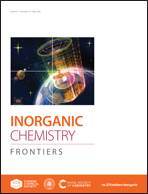Rational design for broad near-infrared emission from a two-sited Rb2LiAlF6:Cr3+ phosphor with high efficiency and thermal stability for spectroscopic applications†
Abstract
The exploration of high-performance near-infrared phosphors has attracted widespread attention. In this work, a brand new Rb2LiAlF6:Cr3+ (denoted as RLAF:Cr) phosphor has been constructed by the substitution of Al3+ ions with Cr3+ ions. Evidence shows that two sets of near-infrared emission bands, which originated from two types of Cr3+ sites, were observed upon blue light excitation. These emission bands merged into a wide emission band locating in the region of 650 nm–1050 nm, with a full width at half maximum (FWHM) of 125 nm. In addition, a high quantum efficiency of 77.7% and an excellent thermal stability at 417 K, with a retention rate of 90.5% of that at room temperature (RT), were witnessed. Profiting from the luminescence properties of the NIR phosphor, clear images of biological tissues and human palm veins were obtained using a light-emitting diode (LED) as a lighting source, which was constructed using an RLAF:Cr phosphor and a blue InGaN chip. These images showed the large potential of the RLAF:Cr phosphor for night vision and bioimaging in LED devices.

- This article is part of the themed collection: FOCUS: Light-emitting diodes technology


 Please wait while we load your content...
Please wait while we load your content...